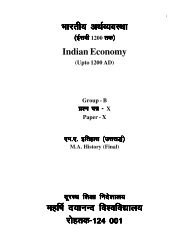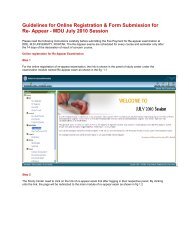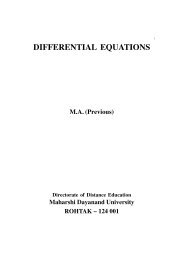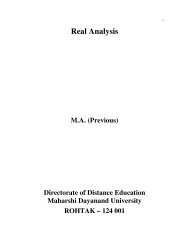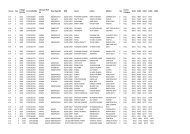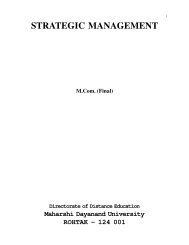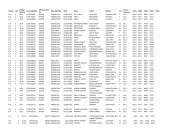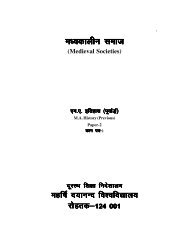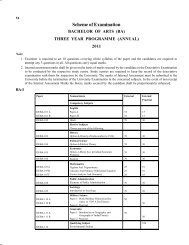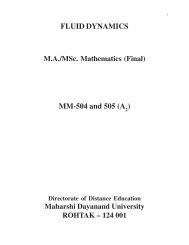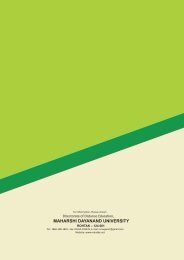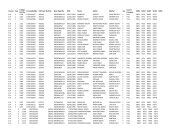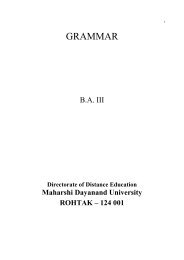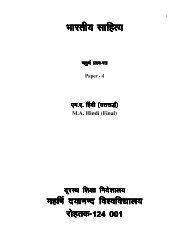Syllabus
Syllabus
Syllabus
Create successful ePaper yourself
Turn your PDF publications into a flip-book with our unique Google optimized e-Paper software.
CORE COURSES<br />
CURRICULUM AND SYLLABUS OF M.L.I.SC.<br />
MLIS-1 : INFORMATION, COMMUNICATION AND SOCIETY<br />
Block-1 : Information: Nature, Property and Scope<br />
Unit-1 - Comparative Study of Data, Information and Knowledge<br />
Unit-2 – Data : Definition, Types, Nature, Properties and Scope<br />
Unit-3 – Information: Definition, Types, Nature, Properties and Scope<br />
Block-2 : Information Generation and Communication<br />
Unit-4 – Communication Process and Media<br />
Unit-5 – Generation of Information: Models and Forms<br />
Unit-6 – Information Theory<br />
Unit-7 – Information Diffusion Process<br />
Block-3 : Knowledge Generation Cycle<br />
Unit-8 – Structure and Development of Knowledge<br />
Unit-9 – Social Epistemology of Knowledge<br />
Unit-10 – Knowledge Generation to Utilization<br />
Unit-11 – Knowledge and Societal Survival<br />
Unit-12 – Learning Process and Theories<br />
Block-4 : Information and Society<br />
Unit-13 – Social Implications of Information<br />
Unit-14 – Information as an Economic Resource<br />
Unit-15 – Information Policies: National and International<br />
Unit-16 – Information Society<br />
MLIS-02 : INFORMATION SOURCES, SYSTEMS AND PROGRAMMES<br />
Block-1 : Multimedia<br />
Unit-1 – Physical Medium of Information<br />
Unit-2 – Print Media, Multimedia (Hypermedia) and Hypertext<br />
Unit-3 – Non-print Media: Microform, Electronic and Optical Media<br />
Block-2 : Information Sources, Systems and Programmes: Subject wise<br />
Organisation<br />
Unit-4 – Humanities<br />
Unit-5 – Social Sciences<br />
Unit-6 – Science and Technology
Unit-7 – Non-Disciplinary Subjects<br />
Unit-8 – International organizations<br />
Block-3 : Information Sources of Users<br />
Unit-9 – Content Analysis and its Correlation to Clientele<br />
Unit-10 – Customised Organisation of Information Sources<br />
Unit-11 – Citation Analysis of Information Sources and their Use<br />
Unit-12 – Aids to Information Sources<br />
Block-4 : Information Experts as resource Persons<br />
Unit-13 – Library and information Personnel<br />
Unit-14 – Science and Technology Information Intermediaries<br />
Unit-15 – Database Designers and Managers<br />
Unit-16 – Media Personnel as Source of Information<br />
MLIS-03 : INFORRMATION PROCESSING AND RETRIEVAL<br />
Block-1 : Intellectual Organisation of Information<br />
Unit-1 – Intellectual Organisation of Information: An Overview<br />
Unit-2 – Classification Systems 1: General Systems<br />
Unit-3 – Classification Systems 1: Special Systems<br />
Unit-4 – Thesaurus: Its Structure and Functions<br />
Block-2 : Bibliographic Description and Subject Indexing<br />
Unit-5 – Bibliographic Description: An Overview<br />
Unit-6 – Standards for Bibliographic Record Format<br />
Unit-7 – Bibliographic Description of Non-Print Media<br />
Unit-8 – Indexing Process and Models<br />
Block-3 : Information Storage and Retrieval Systems<br />
Unit-9 – Objectives of ISAR Systems<br />
Unit-10 – ISAR Systems: Operation and Design<br />
Unit-11 – Compatibility of ISAR Systems<br />
Unit-12 – Evaluation of ISAR Systems<br />
Block-4 : Information Retrieval<br />
Unit-13 – Information Retrieval Process<br />
Unit-14 – The Process of Searching<br />
Unit-15 – Search Strategies and Heuristics<br />
Unit-16 – Common Command Languages and Multiple Database<br />
Searching
MLIS-4 : INFORMATION INSTITUTIONS, PRODUCTS AND SERVICES<br />
Block-1 : Information Institutions<br />
Unit-1 – Information Institutions: Evolution and Growth<br />
Unit-2 – Information Centres: Type and their Organisation<br />
Unit-3 – Data Centres and Referral Centres<br />
Unit-4 – Information Analysis and Consolidation Centres<br />
Block-2 : Information Services<br />
Unit-5 – Literature Searches and Bibliographies<br />
Unit-6 – Technical Enquiry Service<br />
Unit-7 – Document Delivery Service<br />
Unit-8 – Translation Service<br />
Block-3 : Information Products<br />
Unit-9 – Information Newsletters, House Bulletins, In-house<br />
Communications<br />
Unit-10 – Trade and Product Bulletins<br />
Unit-11 – State-the-Art Reports and Trend Reports<br />
Unit-12 – Technical Digests<br />
Block-4 : Database Support Services<br />
Unit-13 – Databases: Types and Uses<br />
Unit-14 – Database Intermediaries such as Searchers, Editors, etc.<br />
Unit-15 – Online Information Systems and Information Networks<br />
Unit-16 – International Standards for Database Design and<br />
Development<br />
MLIS-05 : MANAGEMENT OF LIBRARY AND INFORMATION CENTRES<br />
Block-1 : Management Perspectives<br />
Unit-1 – Principles of Management<br />
Unit-2 – Management Functions<br />
Unit-3 – Managerial Quality and Leadership<br />
Unit-4 – Schools of Management Thought<br />
Block-2 : Systems Analysis and Control<br />
Unit-5 – Systems Analysis and Design<br />
Unit-6 – Work Flow and Organisation Routines<br />
Unit-7 – Monitoring Techniques<br />
Unit-8 – Evaluation Techniques
Block-3 : Personnel Management<br />
Unit-9 – Overview of Personnel Management<br />
Unit-10 – Manpower Planning<br />
Unit-11 – HRD – Quality Improvement Programmes<br />
Block-4 : Financial Management<br />
Unit-12 – Budgeting and Types<br />
Unit-13 – Budgetary Control System<br />
Unit-14 – Costing Techniques<br />
Unit-15 – Cost Analysis<br />
Block-5 : Marketing of Information Products and Services<br />
Unit-16 – Information as a Marketable Commodity<br />
Unit-17 – Pricing of Information Products and Services<br />
Unit-18 – Marketing Strategies<br />
MLIS-06 : APPLICATION OF INFORMATION TECHNOLOGY<br />
Block-1 : Overview of Information Technology<br />
Unit-1 – Overview of Computer Technology<br />
Unit-2 – Overview of Communication Technology<br />
Unit-3 – Overview of reprography and Micrography<br />
Unit-4 – Printing and Publishing Technology<br />
Block-2 : Library Automation<br />
Unit-5 – Use of Computers of Housekeeping Operations<br />
Unit-6 – Computer-based Acquisition Control<br />
Unit-7 – Computer-based Cataloguing<br />
Unit-8 – Computer-based Serials Control<br />
Block-3 : Design and Management of Databases<br />
Block-4 : Networks<br />
Unit-9 – Database Concept and Database Components<br />
Unit-10 – Database Structure, Organisation and Search<br />
Unit-11 – Database Management Systems<br />
Unit-12 – Resource Sharing through Networks<br />
Unit-13 – Networks and their Classification<br />
Unit-14 – Network Architecture and Services<br />
Unit-15 – Bibliographic Information Networks
ELECTIVE COURSES<br />
MLIS-E1 : PRESERVATION AND CONSERVATION OF LIBRARY MATERIAL<br />
Block-1 : Concept of Preservation and Conservation<br />
Unit-1 – Need for Preservation<br />
Unit-2 – Evolution of Writing Materials: Clay, Papyrus, Metallic<br />
Plate, Skin, Parchment, Vellums, Paper etc.<br />
Block-2 : Different Types of Library Materials<br />
Unit-3 – Palm Learves ‘Birch’ Bark: Their Nature and Preservation<br />
Unit-4 – Manuscripts, Books, Periodicals, Newspapers, Pamphlets, etc.<br />
Unit-5 – Non-book Materials: Audio-record, Plates, Tapes, Discs, etc.<br />
Unit-6 – Micro Documents: Microfilm, Microfische, Floppy Diskettes etc.<br />
Block-3 : Hazards to Library Materials and Preservation<br />
Block-4 : Binding<br />
Unit-7 – Environmental Factors – Temperature, Humidity, Water,<br />
Light, Air-pollution, Smoke, Dust, etc.<br />
Unit-8 – Biological Factors – Fungi, Insects, Pests<br />
Unit-9 – Chemical Factors – Chemicals used in Production and<br />
Preservation of Documents<br />
Unit-10 – Different Types of Binding for Library Documents<br />
Unit-11 – Binding Materials and their Varieties<br />
Unit-12 – Binding Process<br />
Unit-13 – Standards for Library Binding<br />
MLIS-E2 : RESERCH METHODOLOGY<br />
Block-1 : Introduction to Research Methodology<br />
Block-2 : Design of Research<br />
Unit-1 – Meaning of Research<br />
Unit-2 – Research Problems and Process of Research<br />
Unit-3 – Sampling and Definition of Universe<br />
Unit-4 – Definition and Types of Research Design<br />
Unit-5 – Observation, Descriptive, Diagnostic, Exploratory and<br />
Experimental Formulations<br />
Unit-6 – Survey Analysis, Content Analysis, Sociometric Technique<br />
Unit-7 – Constructive Typology, Projective Techniques and Statistical<br />
Study<br />
Unit-8 – Case Study and Evaluation Studies
Block-3 : Testing of Hypothesis<br />
Unit-9 – Definition and Delimiting of Problem<br />
Unit-10 – Measures of Central Tendency, Measures of Association, Corelation<br />
Co-efficient, other contingencies<br />
Unit-11 – Regression Analysis and Time Series Analysis<br />
Unit-12 – Analysis and Inference<br />
Unit-13 – Report Writing: Organisation of Report, Table Presentation<br />
and Reporting Format, Graphics in Report Presentation<br />
MLIS-E3 : ACADEMIC LIBRARY SYSTEM<br />
Block-1 : Academic Library<br />
Unit-1 – Role of Academic Library in Education<br />
Unit-2 – Academic Library as a Support System for Education<br />
Block-2 : Development of Academic Library<br />
Unit-3 – Role of UGC in Promoting Academic Libraries, University,<br />
College and other Institutions<br />
Unit-4 – Role of Library Authorities of the Institutions in Promoting<br />
Library Resources<br />
Unit-5 – Development of Library Services<br />
Unit-6 – Financial Management of Academic Libraries<br />
Block-3 : Collection Development<br />
Unit-7 – Collection Development Policy, Weeding Policy<br />
Unit-8 – Problems in Collection Organisation in an Academic Library<br />
Unit-9 – Collection Development Programmes, Allocation of Funds to<br />
Collection-procurement, Curriculum and Collection<br />
Development<br />
Unit-10 – Library Committees and their Role in Collection Development<br />
Block-4 : Staffing and Staff Development for Academic Library<br />
Unit-11 – Norms and Patterns for Staffing University, College and<br />
School Libraries<br />
Unit-12 – Continuing Education Programmes for Academic Library<br />
Development<br />
Unit-13 – Personnel Management in Academic Library<br />
Block-5 : Resource Sharing Programmes<br />
Unit-14 – Resource Sharing Service – Its Objectives, Organisation and<br />
Development<br />
Unit-15 – INFLIBENT and its Implications to Library Resource Sharing<br />
Unit-16 – Regional and City Network of Libraries and their Importance
MLIS-E4 : TECHNICAL WRITING<br />
Block-1 : Communication Process<br />
Block-2 : Linguistics<br />
Unit-1 – Overview of Communication Process<br />
Unit-2 – Characteristic Features of Technical Writing<br />
Unit-3 – Target Groups in Written Communication<br />
Unit-4 – Reader-Writer Relationship<br />
Unit-5 – Language as Medium for Communication of Thought<br />
Unit-6 – Functional English Style: Semantics, Syntax, and Diction<br />
Unit-7 – Readability and Text<br />
Unit-8 – Aberrations in Technical Writing<br />
Block-3 : Structure and Functions of Technical Communication<br />
Unit-9 – Structure: Definition, Purpose, Characteristics and Functions<br />
Unit-10 – Collection, Organisation and Presentation of Data including<br />
Illustrations<br />
Unit-11 – Case Studies: Preparation of Short Communication, Review<br />
Articles, Technical Reports, Monographs, Dissertations and<br />
House Bulletins<br />
Block-4 : Technical Editing and Editorial Tools<br />
Unit-12 – The Editor<br />
Unit-13 – Editorial Process<br />
Unit-14 – Editorial Tools<br />
MLIS-E5 : INFORMETRICS AND SCIENTOMETRICS<br />
Block-1 : Foundation of Informetrics and Scientometrics<br />
Unit-1 – Measuring of Information<br />
Unit-2 – Information Measures: Shanon<br />
Unit-3 – Informetrics: Definition, Scope and Evoluation<br />
Unit-4 – Sociology of Science and Sciento<br />
Unit-5 – Organisations Engaged in Sciento metrics and Informetric<br />
Studies<br />
Block-2 : Informetrics: Elements and Applications<br />
Unit-1 – Law of Scattering and its Applications<br />
Unit-2 – Rank and Size of Frequency Models<br />
Unit-3 – Informetrics Phenomena<br />
Unit-4 – Analysis of Library related Data<br />
Unit-5 – User Studies
Block-3 : Scientometrics: Elements and Applications<br />
Unit-1 – Laws of Scientific Productivity<br />
Unit-2 – Growth and Obsolescene of Liter<br />
Unit-3 – Science Indicators<br />
Unit-4 – Mapping of Science<br />
Block-4 : Techniques and Modeling in Informetrics and Scientometrics<br />
Unit-1 – Elements of Statistics<br />
Unit-2 – Probability Distributions and their Application<br />
Unit-3 – Regression Analysis<br />
Unit-4 – Cluster Analysis and Factor Analysis<br />
MLIS-E6 : PUBLIC LIBRARY SYSTEM AND SERVICES<br />
Block-1 : Public Library: Basic Concepts<br />
Unit-1 – Public Library: Origin and Growth<br />
Unit-2 – Public Library and Society<br />
Unit-3 – Agencies in the Promotion and Development of Public Library<br />
System<br />
Unit-4 – National Library Policy and Library Legislation<br />
Block-2 : Public Library System: Resource Development<br />
Unit-5 – Development Plans and Resource Mobilisation<br />
Unit-6 – Financial Resources<br />
Unit-7 – Physical and Documentary Resources<br />
Unit-8 – Human Resources<br />
Block-3 : Management of Public Library System<br />
Unit-9 – Organisational Structure of Public Library System<br />
Unit-10 – Planning and Administration of Public Libraries<br />
Unit-11 – Public Library Norms, Standards and Guidelines<br />
Unit-12 – Governance of Public Libraries<br />
Unit-13 – Performance Evaluation<br />
Block-4 : Public Library Services<br />
Unit-14 – Types of Library Services<br />
Unit-15 – Application of Information Technology to Public Library<br />
Services<br />
Unit-16 – Resource Sharing Networking<br />
Unit-17 – Public Library Scenario in India, UK, USA and Canada
<strong>Syllabus</strong> for Master of Library and Information Science<br />
Object and Scope<br />
The general objective of programme is towards contribute to building profession manpower<br />
force conducive to meet the varied demands for information handling in the country. Areas focused<br />
the systematic exposure to information Science are to<br />
i) View information essentially as development input<br />
ii)<br />
iii)<br />
Familiarize the students with variety of information techniques and technology; and<br />
Help to promote their managerial ability and develop profession insight participation<br />
in this programme<br />
The programme comprises 8 courses. Duration of programme is one academic year. At the<br />
end of year, a student can take annual examination. Maximum time provided for completion<br />
of 8 courses in different sitting is 4 years. English is the mode of instruction. However<br />
candidate is allowed to write assignments and final examination either in Hindi or English.<br />
The details of marks are given below



